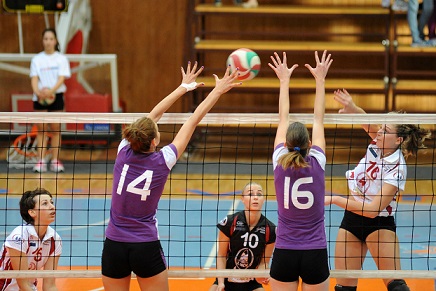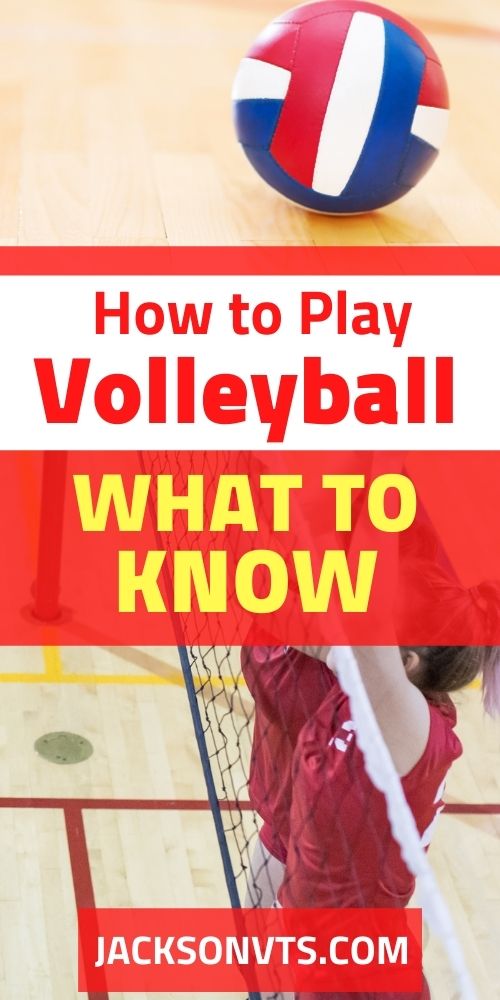Do you need advice on how to play volleyball?
Understand the Sports Lingo
Understanding terms can go a long way in helping your success on the court.
Especially if you are trying out for a team, the better you can understand the language of volleyball, the better you’ll be at communicating with your coach.
A “joust” in volleyball
If you can speak the lingo, you’ll be more comfortable playing and your coach will more likely pick you to be on the team.
Terms that all players should understand are…
- free ball, base position, crosscourt, down ball, dump, float serve
- forearm pass, joust, kill, libero, collective block, off-speed attack
- overhand pass, overlap, overpass, overset, pancake, perimeter defense
- red defense, blue defense, man up defense, scoring in transition
- quick set, reading the play, roll shot, side-out, slide attack, soft block
- tip, tool, topspin, W formation, 5-1 offense, 6-2 offense, 4-2 offense

Understand the Basic Rules and Terminology
Before stepping onto the court, you first need to understand a few rules.
The more you understand and know the rules, the more prepared you’ll be to play the sport of volleyball.
Are you Prepared to Succeed?
Tips and Techniques for Success
The more you understand the rules and strategies of the game, the more you’ll enjoy the experience.
Enjoying your first experience playing is key to continuing to want to play the sport.
Getting a grasp on what’s going on isn’t too difficult, but it will take some effort on your part.
If you enjoyed these tips and would like to keep it close to you at any time, just save this pin to your Pinterest Volleyball Training Board.

Review the Basic Rules for How to Play Volleyball
Be sure to review the basic rules before your first practices and games.
Rather than plunging in and attempting to memorize all the rules in a single sitting, try to review them for a little while every day until you get comfortable with them.
Don’t take learning rules for granted. You can really broaden your understanding of the game by learning the rules and this can lead to a greater confidence, making playing learning how to play volleyball more fun.
What to Bring to the Court
You don’t want to show up unprepared for competition.
Be sure to bring the following items…
- Water bottle. Bring a water bottle with your name clearly marked on it. You don’t want friends sharing your water bottle and have germs being spread around.
- Shoes. You need to wear shoes that are appropriate to wear on a court. Mizuno shoes are a brand of shoe popular for volleyball. Nfinity shoes are shoes made specifically for volleyball. Asics shoes are also a very popular brand of volleyball shoes.
- Knee pads. Knee pads are important for protecting players’ knees when diving for a ball. Knee pads come in different sizes and styles, so I recommend you try them on to make sure they fit comfortably and don’t compromise your playing ability on the court.
Basic Positions on the Court
The following are the main volleyball positions on the court and how to play volleyball.
Each of these positions involves specialized skills.
Setter
Just like a basketball team has a point guard, and a football team has a quarterback, the volleyball team also has a player that leads the team out on the court. The setter leads the team on offense.
The offense often revolves around the setters skills.
The setters job is to take a ball that’s passed from a passer and set it to an attacker.
Setting is a very important position in volleyball because the better your setter is, the more efficient your offense can be, and the more opportunities your team will have to score points.
Strong side hitter (attacker)
The strong side hitter is also referred to as outside hitter. This player usually plays on the court in the left front position.
The obvious goal of volleyball is to set the ball up at the net so an attacker can hit the ball over the net to the opponents side to score points.
The outside hitter is usually the number one weapon for scoring points and your team will rely on him for most of your offense.
Middle hitter
The middle hitter is also referred to as middle blocker. The middle is mainly responsible for blocking, but sometimes is a big threat for attacking.
The middle hitter is set quick sets to the middle of the court and is often used as a decoy.
For example, if you want your outside hitter to be one-on-one with the opponents blockers, the middle hitter can fake a quick set to the middle, drawing the opposing middle blocker which then leaves the outside hitter in a one-on-one situation.
Outside hitter’s would much rather be one-on-one because it’s much easier to get a kill in that situation.
Opposing hitter (right side hitter)
The opposing hitter is also referred to as weak side hitter. The weak side hitter plays on the right side of the court. The weak side hitter usually gets the least amount of sets and is mainly responsible for blocking the opposing strong side attackers.
Libero
The libero is the team’s main defensive specialist. The libero is a player that specializes at passing and digging.
The libero can replace any player in the back row and each replacement doesn’t count as a substitution.
Defensive specialist
The defensive specialist (DS) is similar to a libero in that this player specializes in passing and digging.
The big difference is that the DS must sub into the game and can only replace a player in one position, whereas the libero can replace anyone on the back row.
How to Play Volleyball Related Pages
Position to Dig
Volleyball digging tips for team defense. How to position on the court for base defense. How to stop the middle attack. Blocking and defensive tips for stopping the quick attack.
Receiving
Serve receive skills and techniques for passing. Combined with anticipation skills, communication is a big part of success in serve receive. Often teams get stuck because they can’t side out…
Passing
Volleyball passing skills are important for winning at volleyball. The forearm pass is the main passing skill and primary skill for receiving a served ball…
Strategies
Volleyball strategies for basic skills. To win in volleyball, you need to understand basic strategy. Developing skills and understanding formations and winning the rally…
Object of the Game
How do you play volleyball? Strategy for winning and the basic skills. Learn about rotation and line up. Develop individual play skills and practice game like drills…
Blocking
Volleyball blocking techniques. Conventional blocking methods and advanced swing blocking. Keys to blocking include moving horizontal along the net, getting in position, penetration, positioning…
Hitting Strategies
Volleyball hitting strategies. Do you have a strategy for spiking or do you just hit the ball hard? The best players not only hit hard, but also place the ball. Learn to how to play volleyball with strategy…
Strategy for Beginners
Volleyball strategy for beginning volleyball teams. Learning fundamental techniques and individual skills training for how to play volleyball. The most important skills for youth players for winning in club volleyball…
Volleyball Played
How to play volleyball. The object of the game is to be the first to score 25 points. You score points by winning the rally. You win the rally in various ways such as the ball landing in…
Dummies
Volleyball for dummies and newbie coaches. Learn about the basics of playing volleyball, rules, and how to coach. Basic skills and rules for playing volleyball…
6-2 Offensive Formation
6-2 volleyball rotation has many advantages. For one thing, you’ll always have the option of setting any of the 3 attackers at the net. This is different than the 5-1 offense…
Court Diagram and Terms
Volleyball court diagram to help explain how to play volleyball. You need to understand the different areas of the court. The back court and front court is divided by a 3 meter line…
Formations
Volleyball formations best for serve reception. Tips on how to line up in serve receive. What serve receive patterns are best. Each formation has advantages and disadvantages…
Rotations
Volleyball rotations for 6 person volleyball. In sixes, certain players can’t overlap and you must understand how to line up on the court. Within each rotation there are certain formations…
Home › How to Play
